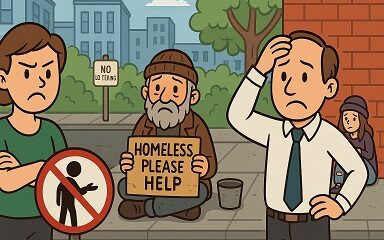Kaiser Health News
Epidemic: The Goddess of Smallpox

by
Tue, 18 Jul 2023 09:00:00 +0000
In the mid-’60s, the national campaign to eradicate smallpox in India was underway, but the virus was still widespread throughout the country. At the time, Dinesh Bhadani was a small boy living in Gaya, a city in the state of Bihar.
In his community many people believed smallpox was divine, sent by the Hindu goddess Shitala Mata. In Bihar people had misgivings about accepting the vaccine because, Bhadani says, they did not want to interfere with the will of the goddess. Others hesitated because making the vaccine required using cows, which are sacred in the Hindu religion. Still others hesitated because the procedure — which involved twirling a barbed disk into a patient’s skin — hurt.
But when Bhadani was 10 years old, he saw the body of a school friend who had died of smallpox. The body was covered in blistering pustules, the skin not visible at all.
Soon after, when eradication workers came to town, young Bhadani remembered his friend, gritted his teeth, and agreed to get the painful vaccine.
Variola major smallpox was deadly and highly contagious. Infected people often died within two weeks — many of them young children. Those who survived could be left severely scarred, infertile, or blind.
Episode 1 of “Eradicating Smallpox” explores the layered cultural landscape that eradication workers navigated as they worked to eliminate the virus. Success required technological innovations, cultural awareness, and a shared dream that a huge public health triumph was possible.
To close the episode, Céline Gounder wonders how the U.S. might tap into similar “moral imagination” to prepare for the next public health crisis.
The Host
Céline Gounder
Senior fellow & editor-at-large for public health, KFF Health News
Céline is senior fellow and editor-at-large for public health with KFF Health News. She is an infectious diseases physician and epidemiologist. She was an assistant commissioner of health in New York City. Between 1998 and 2012, she studied tuberculosis and HIV in South Africa, Lesotho, Malawi, Ethiopia, and Brazil. Gounder also served on the Biden-Harris Transition COVID-19 Advisory Board.
In Conversation with Céline Gounder:
adrienne maree brown
Social justice organizer and science fiction author
Voices from the Episode:
Rajendra Prasad Dhyani
Temple priest at the Shitala Mata Temple in New Delhi
Dinesh Bhadani
Retired Indian Railways station manager living in New Delhi
Priyanka Bhadani
Journalist living in Delhi
Click here to open the transcript
Transcript: The Goddess of Smallpox
Podcast Transcript Epidemic: “Eradicating Smallpox” Season 2, Episode 1: The Goddess of Smallpox Air date: July 18, 2023
Editor’s note: If you are able, we encourage you to listen to the audio of “Epidemic,” which includes emotion and emphasis not found in the transcript. This transcript, generated using transcription software, has been edited for style and clarity. Please use the transcript as a tool but check the corresponding audio before quoting the podcast.
TRANSCRIPT
[street noises]
Céline Gounder:
It’s a hot, humid day in New Delhi. Little shops line the street — food stalls, a kite store, and a small, neighborhood temple nestled among them. And just outside the orange temple gate, a pile of flip-flops and sandals.
[ringing bells and people murmuring]
Céline Gounder:
The temple bells are calling. So, I take off my shoes and head inside. The walls are covered in floral tiles, and all around me, people pray barefoot in the glow of the fluorescent lights. There are offerings of flowers and sweets in front of the statue of the elephant-headed Hindu god, Ganesh. And nearby a less familiar figure: the goddess Shitala Mata.
She’s riding a donkey, with a pitcher of water in one hand and a broom in the other. She wears a fan on her head like a crown. There’s a garland of marigolds strung around her neck. Shitala Mata: the goddess of smallpox.
[music change]
Céline Gounder:
I’m Dr. Céline Gounder. I’m an epidemiologist and infectious disease specialist.
[music change]
Céline Gounder:
My dad grew up in a rural part of southern India, and his childhood there was shaped by relative poverty. Dad was the first person in his village to make it past the fifth grade, smart and fortunate enough to make it to a prestigious university. He came to the United States for grad school and became an engineer.
But he told us stories of the big divides back home in India — in health, in education, in opportunity. Those stories shaped me. Those inequities are a big part of why I chose a career in public health. I became a physician, and over the years worked on infectious disease outbreaks all over the world — tuberculosis, HIV, Ebola, and of course, most recently, covid.
Watching the United States respond to the pandemic got me thinking back to another disease that gripped the world … smallpox. In the 20th century alone, smallpox killed over 300 million people. But in one of the greatest success stories in science, medicine, and public health history, we conquered smallpox. Gone everywhere.
In the summer of 2022, I traveled to India and Bangladesh to seek out that history. This podcast is the story of the final days of smallpox eradication in South Asia. But before we get to that, I want to share what I’m beginning to understand about the role smallpox played in people’s lives.
[murmuring of people]
Céline Gounder:
That’s why I’m here at this temple. Smallpox was seen as part of nature, elemental; something so old, so ingrained in daily life, that it had a place among the gods.
Rajendra Prasad Dhyani:
[Rajendra Prasad Dhyani speaking in Hindi, overlaid with voice actor’s English translation]
I am Rajendra Prasad Dhyani and I serve at the Shitala Mata Temple, Madangir, C First Block. You want to know about Shitala Mata, don’t you?
Céline Gounder:
There are lots of origin stories for Shitala Mata.
[music fades in]
Céline Gounder:
The story the temple priest Rajendra told me starts like this: One day in a village, people were washing clothes. A goddess was wandering the town disguised as an old woman when someone threw scalding water on her.
Rajendra Prasad Dhyani:
[Dhyani speaking in Hindi, overlaid with voice actor’s English translation]
She got blisters all over her body. She got on a donkey and started roaming around the village, screaming in pain.
Céline Gounder:
One of the villagers poured cold water on the old woman. She was magically healed and revealed her true form as the goddess Shitala Mata.
Rajendra Prasad Dhyani:
[Dhyani speaking in Hindi, overlaid with voice actor’s English translation]
She said, “Anyone who suffers from a blistering disease, be it chickenpox or smallpox, if you give them food cooked the night before as my blessing, they will be cured.”
Céline Gounder:
Shitala Mata both gives smallpox and cures it. Her disease can be seen as a curse, a terrible illness, or as a blessing — an opportunity to rest and reflect.
Rajendra Prasad Dhyani:
[Dhyani speaking in Hindi, overlayed with voice actor’s English translation]
She blesses people. She blesses them with peace of mind and calm. Sheetal means cool, so she soothes the mind and bestows devotees with peace of mind. She is the goddess of tranquility.
Céline Gounder:
What Shitala Mata represents in Indian culture is complex.
[music ends]
Céline Gounder:
And defeating smallpox required appreciating and respecting that complexity. It also took medical advances, fresh ideas about epidemiology, unlikely partnerships, and the unwavering dedication of hundreds of thousands of health care workers. We have firsthand accounts from health leaders who were there, some who have never been heard outside of India and Bangladesh.
I’m Dr. Céline Gounder and this is “Epidemic.”
[music interlude]
Céline Gounder:
Today, it’s hard to even imagine what it was like to live in a world with smallpox, where, in the course of your daily life — riding a train, sitting in a classroom, going to work — you could catch a virus so deadly that it killed about 1 in 3 people. That was the death toll before smallpox vaccination became widespread: 1 in 3. And if you did survive, the scars left behind might haunt you for the rest of your life. I met up with someone who lived in those “before times,” when eradication was still a far-off dream.
Dinesh Bhadani:
[Bhadani speaking in a mix of Hindi and English, before the voice actor’s English translation begins]
My name is Dinesh Kumar Bhadani. I am a retired station manager in Indian Railways. Now, my age is 68 years.
Céline Gounder:
I met up with Dinesh Bhadani and his daughter Priyanka at their apartment in New Delhi. As we drank sweet pomegranate juice, Dinesh told me about growing up in the 1960s in Gaya, a small holy city in the eastern state of Bihar. Pilgrims from around the world traveled there to visit the temples. And in the Bihar of Dinesh’s youth, his hometown was one of the last hot spots for smallpox. Dinesh says diseases like smallpox, measles, mumps — they weren’t just a matter of bad luck. To many, they were the will of the gods.
Dinesh Bhadani:
[Bhadani speaking in a mix of Hindi and English, before the voice actor’s English translation begins]
People used to call all of these as some type of wrath from God. People did not consider them illness; people used to say they were divine wraths.
Céline Gounder:
Dinesh’s family home was enormous. It was hundreds of years old. Sometimes more than 50 people cooked together, ate together, and — with little ability to isolate — they got sick together. Especially during a smallpox outbreak.
[music change]
Voice actor speaking in English:
There was an atmosphere of fear because the number of deaths had increased.
Dinesh Bhadani:
[Bhadani speaking in a mix of Hindi and English, before the voice actor’s English translation begins]
At that time, many people died, especially teenagers. A lot of young people died.
Céline Gounder:
Smallpox could spread quickly, traveling from person to person from a cough or a sneeze; through everyday family contact with contaminated bedsheets or towels.
The first signs of infection were usually a high fever, headache, and sometimes vomiting and diarrhea. Then pustules filled with fluid appeared on the body — both inside and out. It was searingly painful. People often died within two weeks — many of them young children. Those who survived could be left severely scarred, infertile, or blind.
A smallpox vaccine has been around since the 18th century, but that protection didn’t reach enough people, so smallpox thrived and continued to kill millions around the world.
Dinesh says he remembers that, in Bihar, people had real misgivings about getting the vaccine. Some didn’t want to interfere with the will of the goddess Shitala Mata. Other people hesitated because of the vaccine itself. And the procedure could hurt.
Dinesh Bhadani:
[Bhadani speaking in a mix of Hindi and English, before the voice actor’s English translation begins]
They were afraid that it was painful. That’s why people would run away, like, “We will not take it.”
Céline Gounder:
Smallpox vaccinations in the 1960s really did hurt more than the quick shots we get today. Health workers dipped a rotating barbed disc into the vaccine solution and then twirled it into a patient’s skin. The vaccine entered the body through these open wounds. It was a brutal procedure.
Dinesh Bhadani:
[Bhadani speaking in a mix of Hindi and English, before the voice actor’s English translation begins]
It used to be very painful. It took more than one week to heal.
Céline Gounder:
But as more and more people fell ill, the calculus of fear began to change. For Dinesh, it happened when he was 10. A classmate died of smallpox. It was the mid-1960s.
Dinesh Bhadani:
[Bhadani speaking in Hindi]
He was a very handsome boy. He was the most good-looking boy in our group.
Céline Gounder:
Dinesh was curious about what happened to his friend, so he went to see the body.
Dinesh Bhadani:
[Bhadani speaking in a mix of Hindi and English, before the voice actor’s English translation begins]
The skin was not visible at all. It looked like a person who got burned, whose entire skin had been burnt. There were blisters all over his body, and a foul smell was coming from his body.
Céline Gounder:
Dinesh was so terrified that he couldn’t sleep for three days.
Dinesh Bhadani:
[Bhadani speaking in a mix of Hindi and English, before the voice actor’s English translation begins]
The fear that it created, after seeing him, after witnessing his death — fear spread among people, like, “Let’s take the vaccine so that we don’t have to face these kinds of deaths.”
Céline Gounder:
There was a vaccine camp at his school, and Dinesh lined up for his dose. Then health workers went house to house, knocking on doors to find any children they’d missed. In the end, Dinesh says, every student at his school was vaccinated. And that feeling of fear that gripped the community began to fade. School by school and town by town, health workers repeated this painstaking work across the state of Bihar.
[music fades in]
Céline Gounder:
Decades after smallpox was eradicated, it was hard for people who had survived the disease to really leave it behind.
[music fades away]
Céline Gounder:
Dinesh’s daughter Priyanka Bhadani says that when she was maybe 10 or 12 years old, she started noticing how the adults around her reacted to lingering smallpox scars. It was the 1990s by then.
Priyanka Bhadani:
I realized that a lot of people were not welcome in the house — a lot of people with those marks that smallpox left on their bodies. So, there’s this one uncle, who couldn’t get married till the time he was 45, 46, because he had these scars.
Céline Gounder:
Survivors like her uncle were isolated, sometimes cut off from society. Priyanka remembers a local businessman who experienced the stigma that often followed someone who’d had smallpox.
Priyanka Bhadani:
He loved one girl in the community; he wanted to get married to that girl. The girl was also in love with him, but then he got smallpox and the family refused, and his entire life was spent in proving himself to be worthy of the girl. So, he established a business, which was huge, for people to take notice of him.
[music begins]
Céline Gounder:
Traveling around New Delhi and Pune, I met several older people with pockmarks on their faces, but this is the last generation with those scars.
In 1980, the World Health Organization declared that smallpox was eradicated — wiped from the planet. It’s one of the greatest triumphs of science, medicine, and public health. But today, roughly 40 years after the disease was defeated, hardly any of my colleagues in public health have any living memory of smallpox, or the Herculean effort it took to eradicate it.
We’re going back in time to consider that history. If we are to overcome current-day crises — from covid to climate change — perhaps there’s something we can learn from those bold leaders of the past. Generations before us imagined a world without smallpox when that goal must have felt like science fiction.
adrienne maree brown: In science fiction, there’s questions that generally guide how we create. So, it’s “What if?” Like … “What if cars could fly? What if everyone had health care? What if?” And “If this goes on …” Where it’s like, “If this goes on the way it is, if nothing was to change, can we live with this?”
Céline Gounder:
Can we live with this?
[music begins]
Céline Gounder:
What would it take to imagine a world with fewer covid deaths? When we come back, we’ll speak with social justice organizer and author adrienne maree brown. She’ll tell us what science fiction can teach us about dreaming up the next great public health triumph.
[music fades away]
Céline Gounder:
Our reporting on what it took to eradicate smallpox has me wishing that our country had a bit more moral imagination as it faces covid and braces for the next public health crisis. Moral imagination is the idea that to solve big problems you have to think big; dream big. Then, you have to fuel those dreams with down-to-earth creativity, empathy, and commitment. Joining us is social justice organizer and science fiction author adrienne maree brown.
adrienne maree brown: It’s really nice to be here and I’m grateful you’re approaching this topic, so let’s see what we can do.
Céline Gounder:
adrienne, whether you’re writing science fiction or organizing for social change, a lot of your work is about imagination. Over the course of my career, and I’m sure you’ve run into this too, of people saying some version of, “This is the way the real world is, or this is just the way it is.”
adrienne maree brown:
Mm-hmm.
Céline Gounder:
And they tell you that some changes aren’t possible, that some ways of doing things just don’t make sense. Where do you find the inspiration to think up, to dream up the worlds that are so wildly different from our present reality?
adrienne maree brown: Saying that stuff is just the way it is, that’s one of the greatest ways that those who currently benefit from the way things are keep us from even imagining that things could be different. For centuries in this country, we were told that slavery was just the way things are, and that it could never be any different. And yet there are people in those systems who said, “This isn’t right. This isn’t fair. Something else is actually possible.”
So a lot of the work of radical imagination, for me, is the work of saying, “Can we imagine a world in which our lives actually matter, and we structure our society around the care that we can give to each other, the care that we need?”
Céline Gounder:
And as part of this idea of radical imagination, I know that you really draw on science fiction as a way of helping us test out solutions to real problems. Is there an example from your fiction, maybe your new book, “Grievers,” of fiction helping provide solutions to real problems?
adrienne maree brown: “Grievers” is the first in a trilogy of books, and in the beginning, the first novella, we have a plague that rolls out through the city of Detroit and stops people from being able to function in any way, and they’re really overcome with what appears to be debilitating grief. And when covid happened, I felt what I had been writing about in the book was in practice. And so, what is emerging in these books is how do we actually come up with plans for surviving changing conditions together?
Céline Gounder:
Well, one of the frustrations I’ve had as a doctor and epidemiologist working in the pandemic is that our leaders seem to think that our current covid death rates are acceptable, even though at the current levels we’d be looking at about a hundred thousand deaths per year. How can we influence change when many people in power aren’t willing to spend more money to save more lives? Especially when it comes to marginalized communities that have been hit hardest by covid.
adrienne maree brown: Mmmm. I think what’s very difficult, and I think what you’ve been pointing to, is we’re in a situation right now where our economic structure works directly against every other aspect of our survival. I lost people to covid. I’m not OK with it; I don’t accept it. And it’s so heartbreaking because it’s like, your government could have protected you from this; your job could have protected you from this. Like there’s so many front lines that could be held that would protect our people.
And I keep coming back to disability justice and disabled communities, ’cause that’s where I see some of the most interesting, hard work happening around this now. ’Cause they’re like, “It’s great that y’all are all trying to rush back into acting all normal. We literally can’t do that. We’re not willing to pay the cost.” And so, watching communities start to figure out how to navigate that with each other: How are disabled communities getting together? Why are we so willing to let so many people die unnecessarily rather than making the necessary pivots inside of our economic models and inside of our approach to community with each other?
Céline Gounder:
Early in the pandemic, it did feel like people were re-imagining things to some degree, like remote learning, you know, or how do you expand access to broadband or access to health care coverage or paid sick and family medical leave for everybody. But now we’re seeing fewer and fewer resources being allocated toward saving lives. People are feeling really beaten down in public health right now. We’re really at an all-time low in terms of morale. Where do you turn to for reminders that another world is possible, that there is hope?
adrienne maree brown: What I have learned is that people cannot jump straight from crisis and despair to like [singing] “a whole new world,” right? You just — that’s not a leap you make.
Each of us is carrying this small piece of this collective grief. These are not numbers. They’re people. They’re mothers and fathers, grandparents, children. They’re people that we loved. And we want to live a life and structure a world that honors what we’ve lost as well as what we’re dreaming of. What does that grief make us want to fight for? What does it make us want to dream up? What does it make us want to open room for?
Céline Gounder:
adrienne, it’s interesting. We’re addressing some of the same issues, but with very different tools. And I’m curious, do you have any final questions for me?
adrienne maree brown: I think my question for you would be, what do you feel like are the most exciting innovations that you wish people understood and knew were in development around this?
Celine Gounder: Oh, interesting. I think it’s not necessarily new innovation.
adrienne maree brown: Mm-hmm.
Céline Gounder:
Sometimes it’s stuff that we already have and we just haven’t scaled up and used. It’s not enough to invent something new. You have to take it to scale.
adrienne maree brown: Yes.
Céline Gounder:
And so, whether that is cleaning the air or paid sick and family medical leave, you know, as many as 15, 20 million people might be losing their Medicaid. Could we imagine everyone having health care or access to health care? What would it take to get there? Um, I think that’s where I’d like to see innovation, is actually in our ability to imagine that.
adrienne maree brown: I love that. These are things that we actually know work, and it’s how do we get people to be in the practice of implementation. So thank you for sharing on that.
Céline Gounder:
Thank you, adrienne. I’ve really enjoyed our conversation.
adrienne maree brown: I’m really glad we got to speak. Thank you, Céline.
[music begins]
Céline Gounder:
That was adrienne maree brown, author of the “Grievers” novels, a speculative fiction series about survival and hope in a pandemic-stricken Detroit.
“Eradicating Smallpox,” our latest season of “Epidemic,” is a co-production of KFF Health News and Just Human Productions.
Additional support provided by the Sloan Foundation.
This episode was produced by Zach Dyer, Jenny Gold, Taylor Cook, and me.
Taunya English is our managing editor.
Oona Tempest is our graphics and photo editor.
The show was engineered by Justin Gerrish.
Voice acting by Ashish Mukerjee and Jatinder Singh Taneja.
Music in this episode is from the Blue Dot Sessions and Soundstripe. We’re powered and distributed by Simplecast.
If you enjoyed the show, please tell a friend. And leave us a review on Apple Podcasts. It helps more people find the show.
Follow KFF Health News on Twitter, Instagram, and TikTok. And find me on Twitter @celinegounder. On our socials there’s more about the ideas we’re exploring on the podcasts.
And subscribe to our newsletters at kffhealthnews.org so you’ll never miss what’s new and important in American health care, health policy, and public health news.
I’m Dr. Céline Gounder. Thanks for listening to “Epidemic.”
[music fades to silence]
Credits
Taunya English
Managing editor
Taunya is senior editor for broadcast innovation with KFF Health News, where she leads enterprise audio projects.
Zach Dyer
Senior producer
Zach is senior producer for audio with KFF Health News where he supervises all levels of podcast production from researching story pitches, interviewing guests to the final mix.
Taylor Cook
Associate producer
Taylor is associate audio producer for Season 2 of Epidemic. She researches, writes, and fact-checks scripts for the podcast.
Oona Tempest
Photo editing, design, logo art
Oona is a digital producer and illustrator with KFF Health News. She researched, sourced, and curated the images for the season.
Additional Newsroom Support
Lydia Zuraw, digital producer Tarena Lofton, audience engagement producer Hannah Norman, visual producer and visual reporter Simone Popperl, broadcast editor Chaseedaw Giles, social media manager Mary Agnes Carey, partnerships editor Damon Darlin, executive editor Terry Byrne, copy chief Chris Lee, senior communications officer
“Epidemic” is a co-production of KFF Health News and Just Human Productions.
To hear other KFF Health News podcasts, click here. Subscribe to “Epidemic” on Apple Podcasts, Spotify, Google, Pocket Casts, or wherever you listen to podcasts.
Title: Epidemic: The Goddess of Smallpox
Sourced From: kffhealthnews.org/news/podcast/epidemic-season-2-episode-1-goddess-of-smallpox/
Published Date: Tue, 18 Jul 2023 09:00:00 +0000
Kaiser Health News
US Judge Names Receiver To Take Over California Prisons’ Mental Health Program

SACRAMENTO, Calif. — A judge has initiated a federal court takeover of California’s troubled prison mental health system by naming the former head of the Federal Bureau of Prisons to serve as receiver, giving her four months to craft a plan to provide adequate care for tens of thousands of prisoners with serious mental illness.
Senior U.S. District Judge Kimberly Mueller issued her order March 19, identifying Colette Peters as the nominated receiver. Peters, who was Oregon’s first female corrections director and known as a reformer, ran the scandal-plagued federal prison system for 30 months until President Donald Trump took office in January. During her tenure, she closed a women’s prison in Dublin, east of Oakland, that had become known as the “rape club.”
Michael Bien, who represents prisoners with mental illness in the long-running prison lawsuit, said Peters is a good choice. Bien said Peters’ time in Oregon and Washington, D.C., showed that she “kind of buys into the fact that there are things we can do better in the American system.”
“We took strong objection to many things that happened under her tenure at the BOP, but I do think that this is a different job and she’s capable of doing it,” said Bien, whose firm also represents women who were housed at the shuttered federal women’s prison.
California corrections officials called Peters “highly qualified” in a statement, while Gov. Gavin Newsom’s office did not immediately comment. Mueller gave the parties until March 28 to show cause why Peters should not be appointed.
Peters is not talking to the media at this time, Bien said. The judge said Peters is to be paid $400,000 a year, prorated for the four-month period.
About 34,000 people incarcerated in California prisons have been diagnosed with serious mental illnesses, representing more than a third of California’s prison population, who face harm because of the state’s noncompliance, Mueller said.
Appointing a receiver is a rare step taken when federal judges feel they have exhausted other options. A receiver took control of Alabama’s correctional system in 1976, and they have otherwise been used to govern prisons and jails only about a dozen times, mostly to combat poor conditions caused by overcrowding. Attorneys representing inmates in Arizona have asked a judge to take over prison health care there.
Mueller’s appointment of a receiver comes nearly 20 years after a different federal judge seized control of California’s prison medical system and installed a receiver, currently J. Clark Kelso, with broad powers to hire, fire, and spend the state’s money.
California officials initially said in August that they would not oppose a receivership for the mental health program provided that the receiver was also Kelso, saying then that federal control “has successfully transformed medical care” in California prisons. But Kelso withdrew from consideration in September, as did two subsequent candidates. Kelso said he could not act “zealously and with fidelity as receiver in both cases.”
Both cases have been running for so long that they are now overseen by a second generation of judges. The original federal judges, in a legal battle that reached the U.S. Supreme Court, more than a decade ago forced California to significantly reduce prison crowding in a bid to improve medical and mental health care for incarcerated people.
State officials in court filings defended their improvements over the decades. Prisoners’ attorneys countered that treatment remains poor, as evidenced in part by the system’s record-high suicide rate, topping 31 suicides per 100,000 prisoners, nearly double that in federal prisons.
“More than a quarter of the 30 class-members who died by suicide in 2023 received inadequate care because of understaffing,” prisoners’ attorneys wrote in January, citing the prison system’s own analysis. One prisoner did not receive mental health appointments for seven months “before he hanged himself with a bedsheet.”
They argued that the November passage of a ballot measure increasing criminal penalties for some drug and theft crimes is likely to increase the prison population and worsen staffing shortages.
California officials argued in January that Mueller isn’t legally justified in appointing a receiver because “progress has been slow at times but it has not stalled.”
Mueller has countered that she had no choice but to appoint an outside professional to run the prisons’ mental health program, given officials’ intransigence even after she held top officials in contempt of court and levied fines topping $110 million in June. Those extreme actions, she said, only triggered more delays.
The 9th U.S. Circuit Court of Appeals on March 19 upheld Mueller’s contempt ruling but said she didn’t sufficiently justify calculating the fines by doubling the state’s monthly salary savings from understaffing prisons. It upheld the fines to the extent that they reflect the state’s actual salary savings but sent the case back to Mueller to justify any higher penalty.
Mueller had been set to begin additional civil contempt proceedings against state officials for their failure to meet two other court requirements: adequately staffing the prison system’s psychiatric inpatient program and improving suicide prevention measures. Those could bring additional fines topping tens of millions of dollars.
But she said her initial contempt order has not had the intended effect of compelling compliance. Mueller wrote as far back as July that additional contempt rulings would also be likely to be ineffective as state officials continued to appeal and seek delays, leading “to even more unending litigation, litigation, litigation.”
She went on to foreshadow her latest order naming a receiver in a preliminary order: “There is one step the court has taken great pains to avoid. But at this point,” Mueller wrote, “the court concludes the only way to achieve full compliance in this action is for the court to appoint its own receiver.”
This article was produced by KFF Health News, which publishes California Healthline, an editorially independent service of the California Health Care Foundation.
If you or someone you know may be experiencing a mental health crisis, contact the 988 Suicide & Crisis Lifeline by dialing or texting “988.”
The post US Judge Names Receiver To Take Over California Prisons’ Mental Health Program appeared first on kffhealthnews.org
Kaiser Health News
Amid Plummeting Diversity at Medical Schools, a Warning of DEI Crackdown’s ‘Chilling Effect’

The Trump administration’s crackdown on DEI programs could exacerbate an unexpectedly steep drop in diversity among medical school students, even in states like California, where public universities have been navigating bans on affirmative action for decades. Education and health experts warn that, ultimately, this could harm patient care.
Since taking office, President Donald Trump has issued a handful of executive orders aimed at terminating all diversity, equity, and inclusion, or DEI, initiatives in federally funded programs. And in his March 4 address to Congress, he described the Supreme Court’s 2023 decision banning the consideration of race in college and university admissions as “brave and very powerful.”
Last month, the Education Department’s Office for Civil Rights — which lost about 50% of its staff in mid-March — directed schools, including postsecondary institutions, to end race-based programs or risk losing federal funding. The “Dear Colleague” letter cited the Supreme Court’s decision.
Paulette Granberry Russell, president and CEO of the National Association of Diversity Officers in Higher Education, said that “every utterance of ‘diversity’ is now being viewed as a violation or considered unlawful or illegal.” Her organization filed a lawsuit challenging Trump’s anti-DEI executive orders.
While California and eight other states — Arizona, Florida, Idaho, Michigan, Nebraska, New Hampshire, Oklahoma, and Washington — had already implemented bans of varying degrees on race-based admissions policies well before the Supreme Court decision, schools bolstered diversity in their ranks with equity initiatives such as targeted scholarships, trainings, and recruitment programs.
But the court’s decision and the subsequent state-level backlash — 29 states have since introduced bills to curb diversity initiatives, according to data published by the Chronicle of Higher Education — have tamped down these efforts and led to the recent declines in diversity numbers, education experts said.
After the Supreme Court’s ruling, the numbers of Black and Hispanic medical school enrollees fell by double-digit percentages in the 2024-25 school year compared with the previous year, according to the Association of American Medical Colleges. Black enrollees declined 11.6%, while the number of new students of Hispanic origin fell 10.8%. The decline in enrollment of American Indian or Alaska Native students was even more dramatic, at 22.1%. New Native Hawaiian or other Pacific Islander enrollment declined 4.3%.
“We knew this would happen,” said Norma Poll-Hunter, AAMC’s senior director of workforce diversity. “But it was double digits — much larger than what we anticipated.”
The fear among educators is the numbers will decline even more under the new administration.
At the end of February, the Education Department launched an online portal encouraging people to “report illegal discriminatory practices at institutions of learning,” stating that students should have “learning free of divisive ideologies and indoctrination.” The agency later issued a “Frequently Asked Questions” document about its new policies, clarifying that it was acceptable to observe events like Black History Month but warning schools that they “must consider whether any school programming discourages members of all races from attending.”
“It definitely has a chilling effect,” Poll-Hunter said. “There is a lot of fear that could cause institutions to limit their efforts.”
Numerous requests for comment from medical schools about the impact of the anti-DEI actions went unreturned. University presidents are staying mum on the issue to protect their institutions, according to reporting from The New York Times.
Utibe Essien, a physician and UCLA assistant professor, said he has heard from some students who fear they won’t be considered for admission under the new policies. Essien, who co-authored a study on the effect of affirmative action bans on medical schools, also said students are worried medical schools will not be as supportive toward students of color as in the past.
“Both of these fears have the risk of limiting the options of schools folks apply to and potentially those who consider medicine as an option at all,” Essien said, adding that the “lawsuits around equity policies and just the climate of anti-diversity have brought institutions to this place where they feel uncomfortable.”
In early February, the Pacific Legal Foundation filed a lawsuit against the University of California-San Francisco’s Benioff Children’s Hospital Oakland over an internship program designed to introduce “underrepresented minority high school students to health professions.”
Attorney Andrew Quinio filed the suit, which argues that its plaintiff, a white teenager, was not accepted to the program after disclosing in an interview that she identified as white.
“From a legal standpoint, the issue that comes about from all this is: How do you choose diversity without running afoul of the Constitution?” Quinio said. “For those who want diversity as a goal, it cannot be a goal that is achieved with discrimination.”
UC Health spokesperson Heather Harper declined to comment on the suit on behalf of the hospital system.
Another lawsuit filed in February accuses the University of California of favoring Black and Latino students over Asian American and white applicants in its undergraduate admissions. Specifically, the complaint states that UC officials pushed campuses to use a “holistic” approach to admissions and “move away from objective criteria towards more subjective assessments of the overall appeal of individual candidates.”
The scrutiny of that approach to admissions could threaten diversity at the UC-Davis School of Medicine, which for years has employed a “race-neutral, holistic admissions model” that reportedly tripled enrollment of Black, Latino, and Native American students.
“How do you define diversity? Does it now include the way we consider how someone’s lived experience may be influenced by how they grew up? The type of school, the income of their family? All of those are diversity,” said Granberry Russell, of the National Association of Diversity Officers in Higher Education. “What might they view as an unlawful proxy for diversity equity and inclusion? That’s what we’re confronted with.”
California Attorney General Rob Bonta, a Democrat, recently joined other state attorneys general to issue guidance urging that schools continue their DEI programs despite the federal messaging, saying that legal precedent allows for the activities. California is also among several states suing the administration over its deep cuts to the Education Department.
If the recent decline in diversity among newly enrolled students holds or gets worse, it could have long-term consequences for patient care, academic experts said, pointing toward the vast racial disparities in health outcomes in the U.S., particularly for Black people.
A higher proportion of Black primary care doctors is associated with longer life expectancy and lower mortality rates among Black people, according to a 2023 study published by the JAMA Network.
Physicians of color are also more likely to build their careers in medically underserved communities, studies have shown, which is increasingly important as the AAMC projects a shortage of up to 40,400 primary care doctors by 2036.
“The physician shortage persists, and it’s dire in rural communities,” Poll-Hunter said. “We know that diversity efforts are really about improving access for everyone. More diversity leads to greater access to care — everyone is benefiting from it.”
This article was produced by KFF Health News, which publishes California Healthline, an editorially independent service of the California Health Care Foundation.
The post Amid Plummeting Diversity at Medical Schools, a Warning of DEI Crackdown’s ‘Chilling Effect’ appeared first on kffhealthnews.org
Kaiser Health News
Tribal Health Leaders Say Medicaid Cuts Would Decimate Health Programs

As Congress mulls potentially massive cuts to federal Medicaid funding, health centers that serve Native American communities, such as the Oneida Community Health Center near Green Bay, Wisconsin, are bracing for catastrophe.
That’s because more than 40% of the about 15,000 patients the center serves are enrolled in Medicaid. Cuts to the program would be detrimental to those patients and the facility, said Debra Danforth, the director of the Oneida Comprehensive Health Division and a citizen of the Oneida Nation.
“It would be a tremendous hit,” she said.
The facility provides a range of services to most of the Oneida Nation’s 17,000 people, including ambulatory care, internal medicine, family practice, and obstetrics. The tribe is one of two in Wisconsin that have an “open-door policy,” Danforth said, which means that the facility is open to members of any federally recognized tribe.
But Danforth and many other tribal health officials say Medicaid cuts would cause service reductions at health facilities that serve Native Americans.
Indian Country has a unique relationship to Medicaid, because the program helps tribes cover chronic funding shortfalls from the Indian Health Service, the federal agency responsible for providing health care to Native Americans.
Medicaid has accounted for about two-thirds of third-party revenue for tribal health providers, creating financial stability and helping facilities pay operational costs. More than a million Native Americans enrolled in Medicaid or the closely related Children’s Health Insurance Program also rely on the insurance to pay for care outside of tribal health facilities without going into significant medical debt. Tribal leaders are calling on Congress to exempt tribes from cuts and are preparing to fight to preserve their access.
“Medicaid is one of the ways in which the federal government meets its trust and treaty obligations to provide health care to us,” said Liz Malerba, director of policy and legislative affairs for the United South and Eastern Tribes Sovereignty Protection Fund, a nonprofit policy advocacy organization for 33 tribes spanning from Texas to Maine. Malerba is a citizen of the Mohegan Tribe.
“So we view any disruption or cut to Medicaid as an abrogation of that responsibility,” she said.
Tribes face an arduous task in providing care to a population that experiences severe health disparities, a high incidence of chronic illness, and, at least in western states, a life expectancy of 64 years — the lowest of any demographic group in the U.S. Yet, in recent years, some tribes have expanded access to care for their communities by adding health services and providers, enabled in part by Medicaid reimbursements.
During the last two fiscal years, five urban Indian organizations in Montana saw funding growth of nearly $3 million, said Lisa James, director of development for the Montana Consortium for Urban Indian Health, during a webinar in February organized by the Georgetown University Center for Children and Families and the National Council of Urban Indian Health.
The increased revenue was “instrumental,” James said, allowing clinics in the state to add services that previously had not been available unless referred out for, including behavioral health services. Clinics were also able to expand operating hours and staffing.
Montana’s five urban Indian clinics, in Missoula, Helena, Butte, Great Falls, and Billings, serve 30,000 people, including some who are not Native American or enrolled in a tribe. The clinics provide a wide range of services, including primary care, dental care, disease prevention, health education, and substance use prevention.
James said Medicaid cuts would require Montana’s urban Indian health organizations to cut services and limit their ability to address health disparities.
American Indian and Alaska Native people under age 65 are more likely to be uninsured than white people under 65, but 30% rely on Medicaid compared with 15% of their white counterparts, according to KFF data for 2017 to 2021. More than 40% of American Indian and Alaska Native children are enrolled in Medicaid or CHIP, which provides health insurance to kids whose families are not eligible for Medicaid. KFF is a health information nonprofit that includes KFF Health News.
A Georgetown Center for Children and Families report from January found the share of residents enrolled in Medicaid was higher in counties with a significant Native American presence. The proportion on Medicaid in small-town or rural counties that are mostly within tribal statistical areas, tribal subdivisions, reservations, and other Native-designated lands was 28.7%, compared with 22.7% in other small-town or rural counties. About 50% of children in those Native areas were enrolled in Medicaid.
The federal government has already exempted tribes from some of Trump’s executive orders. In late February, Department of Health and Human Services acting general counsel Sean Keveney clarified that tribal health programs would not be affected by an executive order that diversity, equity, and inclusion government programs be terminated, but that the Indian Health Service is expected to discontinue diversity and inclusion hiring efforts established under an Obama-era rule.
HHS Secretary Robert F. Kennedy Jr. also rescinded the layoffs of more than 900 IHS employees in February just hours after they’d received termination notices. During Kennedy’s Senate confirmation hearings, he said he would appoint a Native American as an assistant HHS secretary. The National Indian Health Board, a Washington, D.C.-based nonprofit that advocates for tribes, in December endorsed elevating the director of the Indian Health Service to assistant secretary of HHS.
Jessica Schubel, a senior health care official in Joe Biden’s White House, said exemptions won’t be enough.
“Just because Native Americans are exempt doesn’t mean that they won’t feel the impact of cuts that are made throughout the rest of the program,” she said.
State leaders are also calling for federal Medicaid spending to be spared because cuts to the program would shift costs onto their budgets. Without sustained federal funding, which can cover more than 70% of costs, state lawmakers face decisions such as whether to change eligibility requirements to slim Medicaid rolls, which could cause some Native Americans to lose their health coverage.
Tribal leaders noted that state governments do not have the same responsibility to them as the federal government, yet they face large variations in how they interact with Medicaid depending on their state programs.
President Donald Trump has made seemingly conflicting statements about Medicaid cuts, saying in an interview on Fox News in February that Medicaid and Medicare wouldn’t be touched. In a social media post the same week, Trump expressed strong support for a House budget resolution that would likely require Medicaid cuts.
The budget proposal, which the House approved in late February, requires lawmakers to cut spending to offset tax breaks. The House Committee on Energy and Commerce, which oversees spending on Medicaid and Medicare, is instructed to slash $880 billion over the next decade. The possibility of cuts to the program that, together with CHIP, provides insurance to 79 million people has drawn opposition from national and state organizations.
The federal government reimburses IHS and tribal health facilities 100% of billed costs for American Indian and Alaska Native patients, shielding state budgets from the costs.
Because Medicaid is already a stopgap fix for Native American health programs, tribal leaders said it won’t be a matter of replacing the money but operating with less.
“When you’re talking about somewhere between 30% to 60% of a facility’s budget is made up by Medicaid dollars, that’s a very difficult hole to try and backfill,” said Winn Davis, congressional relations director for the National Indian Health Board.
Congress isn’t required to consult tribes during the budget process, Davis added. Only after changes are made by the Centers for Medicare & Medicaid Services and state agencies are tribes able to engage with them on implementation.
The amount the federal government spends funding the Native American health system is a much smaller portion of its budget than Medicaid. The IHS projected billing Medicaid about $1.3 billion this fiscal year, which represents less than half of 1% of overall federal spending on Medicaid.
“We are saving more lives,” Malerba said of the additional services Medicaid covers in tribal health care. “It brings us closer to a level of 21st century care that we should all have access to but don’t always.”
This article was published with the support of the Journalism & Women Symposium (JAWS) Health Journalism Fellowship, assisted by grants from The Commonwealth Fund.
KFF Health News is a national newsroom that produces in-depth journalism about health issues and is one of the core operating programs at KFF—an independent source of health policy research, polling, and journalism. Learn more about KFF.
USE OUR CONTENT
This story can be republished for free (details).
The post Tribal Health Leaders Say Medicaid Cuts Would Decimate Health Programs appeared first on kffhealthnews.org
-

 Mississippi Today6 days ago
Mississippi Today6 days agoLawmakers used to fail passing a budget over policy disagreement. This year, they failed over childish bickering.
-

 Mississippi Today6 days ago
Mississippi Today6 days agoOn this day in 1873, La. courthouse scene of racial carnage
-

 Local News7 days ago
Local News7 days agoAG Fitch and Children’s Advocacy Centers of Mississippi Announce Statewide Protocol for Child Abuse Response
-

 Local News6 days ago
Local News6 days agoSouthern Miss Professor Inducted into U.S. Hydrographer Hall of Fame
-

 News from the South - Alabama News Feed4 days ago
News from the South - Alabama News Feed4 days agoFoley man wins Race to the Finish as Kyle Larson gets first win of 2025 Xfinity Series at Bristol
-

 News from the South - Alabama News Feed5 days ago
News from the South - Alabama News Feed5 days agoFederal appeals court upholds ruling against Alabama panhandling laws
-

 Our Mississippi Home7 days ago
Our Mississippi Home7 days agoFood Chain Drama | Our Mississippi Home
-

 News from the South - North Carolina News Feed7 days ago
News from the South - North Carolina News Feed7 days agoHelene: Renewed focus on health of North Carolina streams | North Carolina


















































